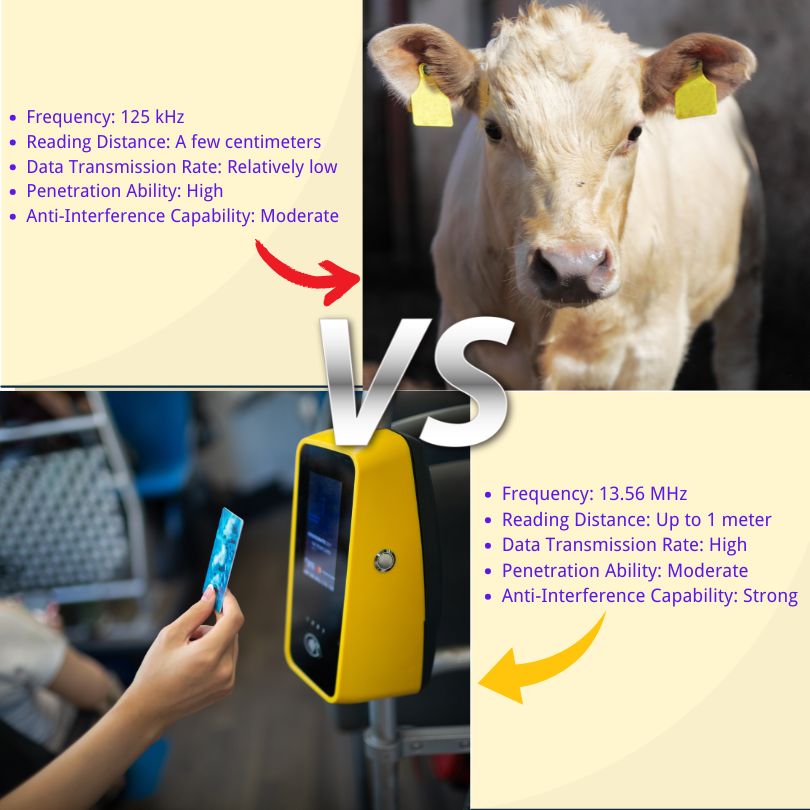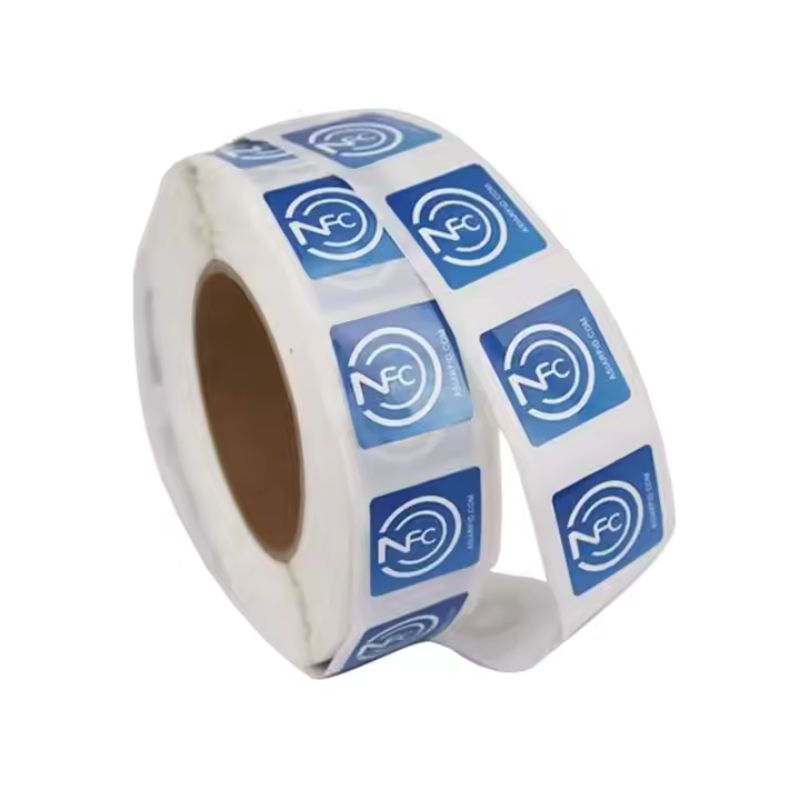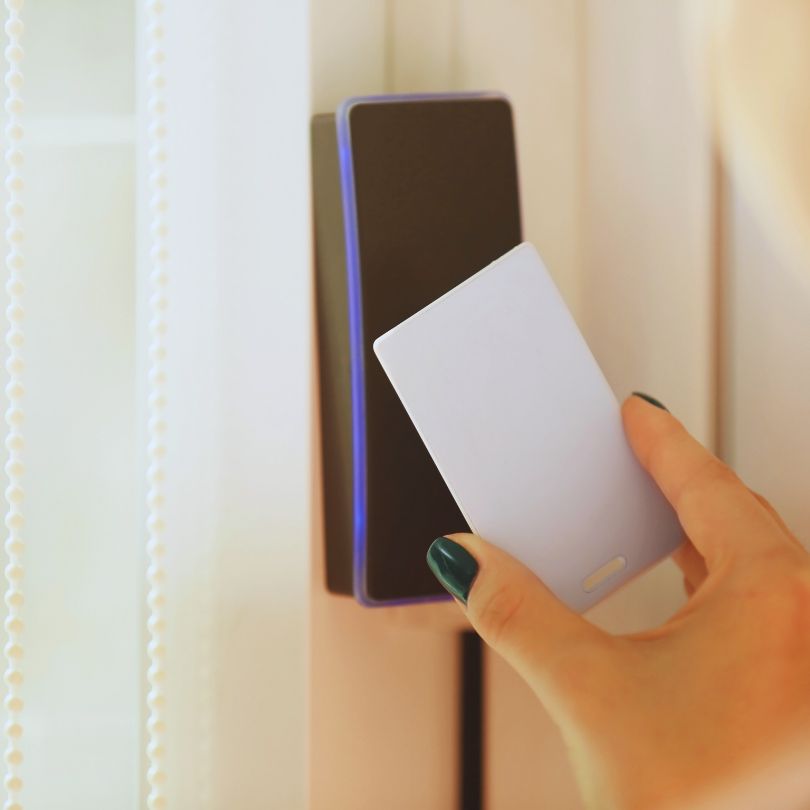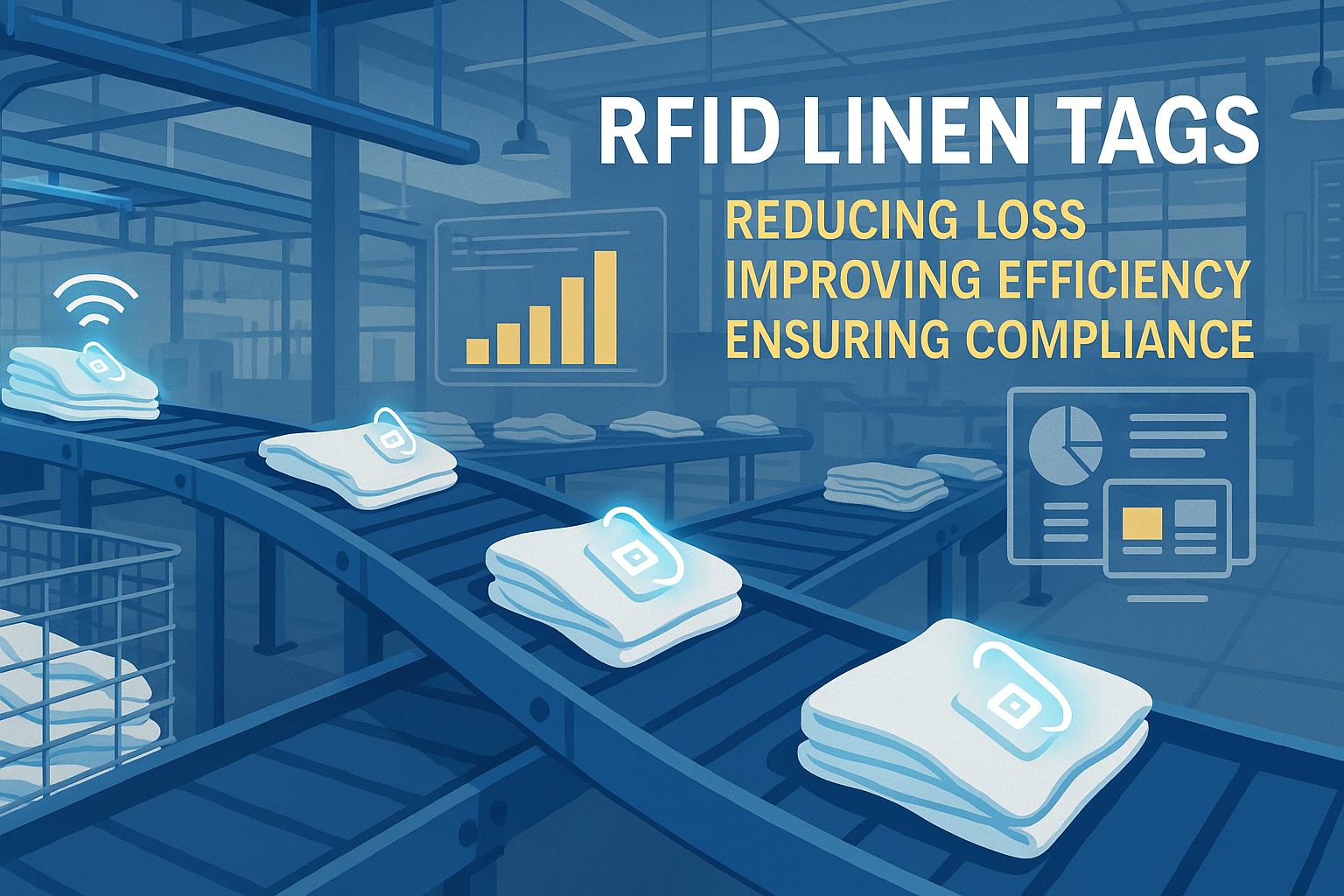
13.56 MHz と 125 kHz の RFID タグの違いを理解する
目次
13.56 MHz と 125 kHz の RFID タグの違いを理解する

RFID周波数の真の意味(LF対HF)
RFIDシステムは電波を用いて通信を行う タグ そしてリーダー。使用頻度は、読み取り可能距離、データ送信速度、金属や水に対する挙動、保存可能なデータの種類に影響を与えます。.
核心となる考え方は次の通りです:
低周波(LF)= 125 kHz RFIDタグ
- 短距離
- 低速のデータ転送速度
- 金属や液体付近での優れた性能
- シンプルで頑丈、そして手頃な価格
高周波(HF)= 13.56 MHz RFID タグ - より長い範囲
- より高速なデータ転送速度
- より高度なセキュリティ
- NFCおよびスマートフォンに対応
13.56 MHz 対 125 kHz
| 特徴 | 13.56 MHz RFID タグ | 125 kHz RFID タグ |
|---|---|---|
| 頻度 | 13.56 MHz (HF) | 125 kHz (LF) |
| 読み取り範囲 | 最大1メートル | 2-10 cm |
| データ転送速度 | 高い | 低い |
| 金属近傍での性能 | 適度 | 強い |
| 安全 | 暗号化、相互認証をサポートします | 基本、通常は暗号化なし |
| NFC / スマートフォン対応 | はい | いいえ |
| 料金 | より高い | より低い |

セキュリティ:単一周波数はより安全か?
125 kHz RFID タグ 古いシステムでよく使用され、通常は暗号化のない固定の一意IDを使用します。そのため市販のデバイスで簡単に複製できます。低リスクのシステムには問題ありませんが、現代のセキュリティ基準には適合しません。.
13.56 MHz RFIDタグ、特にMIFAREまたはDESFireカードは以下をサポートします:
- 暗号化
- 相互認証
- 安全なメモリ保存
- 一枚のカードに複数のアプリケーション
要するに: - 低セキュリティ用途(ロッカーキーやタイムレコーダーなど)には125kHz RFIDタグを使用してください。.
- アクセス制御、決済、または個人データを保存するシステムには13.56 MHzを選択してください。.
NFCとスマートフォンの互換性
プロジェクトに携帯電話が関与する場合、125kHzのRFIDタグは機能しません。.
ただ 13.56 MHz RFID タグ NFC(近距離無線通信)をサポート—モバイル決済、チェックイン、タップでペアリング機能などに使用される技術。.
ほとんどのスマートフォンは13.56MHzでNFCタグの読み書きが可能であり、この周波数は以下に最適です:
- デジタルチケット
- イベントチェックイン
- スマートポスター
- ポイントカード
- 非接触型モバイルID
スマートフォン対応が重要なら、13.56 MHzが唯一の選択肢です。.
業界別実例
| 産業/用途 | 125 kHz RFID タグ | 13.56 MHz RFID タグ |
|---|---|---|
| アクセス制御 | 基本入室システム、レガシードア | セキュアな認証情報、最新のIDバッジ |
| 公共交通機関/切符 | サポートされていません | MIFARE/NFCベースの運賃カード |
| 動物の追跡 | 組織への浸透性が高いため広く使用されている | レア |
| 産業オートメーション | 金属/液体付近でも信頼性が高く、頑丈な使用に耐える | 過酷な環境ではあまり見られない |
| 健康管理 | 患者や薬剤の追跡には適していない | より安全なID管理と資産タグ付けに適している |
| 図書館/公文書館 | レア | 書籍の貸出管理と貸出に人気 |
| マーケティング/イベント | 該当なし | スマートポスター、NFCイベントパス |
| 車両盗難防止 | キー/イグニッションに埋め込まれた125kHz RFIDタグ | 未使用 |

プロジェクトにおける13.56MHzと125kHzの選択方法
このチェックリストを使って判断を絞り込んでください:
1. セキュリティレベル
- 暗号化や安全なアクセスが必要ですか? → 13.56 MHzを選択してください
- 低リスク追跡または基本ID? → 125kHzで十分かもしれない。.
2. 環境
- 周囲に高干渉、金属、または液体がありますか? → 125 kHzの方が効果的です
- 清潔なオフィスまたは屋内スペース? → どちらでも可。機能に基づいて選択してください。.
3. スマートフォン連携
- ユーザーにスマートフォンでスキャンしてほしい? → 13.56MHzのみがこれをサポートしています
4. 予算
- 125kHzタグは初期費用が安い
- しかし、機能やセキュリティが必要な場合には、13.56MHzの方が長期的な価値を提供します。.
まだ125kHzのRFIDタグを使っていますか? アップグレードすべきか、現状維持すべきか?
125 kHz RFIDタグは、現在も以下で広く使用されています:
- レガシーアクセス制御システム
- 工場現場の操業
- 家畜のタグ付け
- 自動車用盗難防止システム
しかし、もしあなたが管理しているなら: - スタッフ資格証明書
- 決済システム
- 多目的IDカード
- NFC統合
…そろそろ切り替える時かもしれない。.
アップグレードパス:
- デュアル周波数リーダーを設置する
- コンボカード(13.56MHzと125kHzの両方に対応)を発行する
- 段階的導入:移行期間中は両システムを同時にサポートする
13.56MHzと125kHzのRFIDに関するよくある質問
13.56 MHzはNFCと同じですか?
はい、NFCは13.56MHzのRFIDの一種です。ほとんどのスマートフォンが対応しています。.
一つの読取装置で両方の周波数を読み取れますか?
通常はそうではありません。両方に対応するにはデュアルテクノロジー対応リーダーが必要です。.
どちらのタグの通信距離が長いですか?
13.56 MHzは一般的に読み取り範囲が長い(最大1メートル)。125 kHzは数センチメートルに制限される。.
アクセス制御にはどちらを使用すべきですか?
現代的で安全なアクセスシステムには、13.56 MHzが強く推奨されます。.
13.56 MHz と 125 kHz の RFID タグの読み取り距離が異なるのはなぜですか?
読み取り距離の違いは、主に動作周波数によるものです。13.56 MHz などの高周波数では範囲が広くなり、125 kHz などの低周波数では距離が短くなるように最適化されています。
金属環境または液体環境に適した RFID タグはどれですか?
125 kHz RFID タグは、優れた浸透能力を備えているため、金属や液体のある環境でより効果的です。
RFID タグのコストは選択に影響しますか?
はい、125 kHz RFID タグは一般的にコスト効率が高く、予算重視のアプリケーションに適したオプションです。ただし、選択する際にはパフォーマンス要件とアプリケーション環境も考慮する必要があります。
主要規格とチップタイプ
13.56 MHz (HF)
- ISO/IEC 14443: 非接触型カード(MIFARE、DESFire)に使用される
- ISO/IEC 15693: 長距離通信、図書館・物流分野で使用
- ISO 18000-3: アイテムレベル追跡
125 kHz (LF)
- 独自フォーマット(固定ID形式が多い、例:EM4100、HID Prox)
- 主に古いシステムや基本的なアプリケーションで使用される
最終的な要点
まだどちらに進むか迷っているなら、要約するとこうです:
125 kHz RFIDタグの使用用途:
- 過酷な条件(金属/液体)
- 低セキュリティアプリケーション
- 予算重視の導入
- レガシーシステム
13.56 MHz RFIDタグの使用用途:
- モバイル/NFC対応
- 安全なアクセスと支払い
- 多目的カード
- 未来に対応したシステム
どちらも存在意義はあるが、コストや習慣だけでなく、使用ケースに基づいて選ぶべきだ。.
コメント
人気商品

RFID廃棄物管理とは何か
想像してみてください。街中のゴミ箱がすべて「話す」街を――文字通りではなく――小さなチップを通じて、満杯になった時、空になった時、そしてどこへ運ばれたかをシステムに伝えるのです。それが今日のRFID廃棄物管理の仕組みです。.

ボルトシールとその用途とは?| 完全ガイド
世界的な貿易と物流において、ボルトシールは貨物のセキュリティとコンプライアンスを確保する上で重要な役割を果たしています。これらの小型で強力なデバイスは、タンパーエビデント機構で輸送コンテナ、トレーラー、貨物ドアをロックするように設計されています。

RFIDカードプロテクターとは?メリット、使用例、購入ガイド
RFID(Radio Frequency Identification)テクノロジーは、クレジットカード、IDバッジ、定期券、ホテルのルームキーなど、あらゆるところに浸透している。RFIDはスピードと利便性を提供する一方で、「スキミング」と呼ばれる新たなデジタル窃盗への扉も開いている。そこでRFIDカードプロテクターの出番です。

イベント用RFIDリストバンド:主催者向け一括購入ガイド
イベント用RFIDリストバンドは、コンサート、フェスティバル、スポーツ会場などで、迅速な入場、不正防止、キャッシュレス決済を必要とする主催者にとって、最適なソリューションになりつつあります。紙のチケットやQRコードとは異なり、これらのスマートリストバンドは埋め込みチップを使用し、アクセスを合理化し、取引を安全にし、ゲストの体験を向上させます。

フロントガラス上のRFIDタグが車両入退場管理と料金システムを改善する方法
ペースの速い今日の世界では、車両識別は迅速、安全、非接触である必要があります。フロントガラス上のRFIDタグは、まさにそれを提供します-車両を止めることなく、料金徴収、駐車、ゲートアクセスを管理する信頼性の高い方法です。

業務用ランドリーにおけるRFIDリネンタグの利点
病院やホテル、大規模なランドリーサービスでのランドリー管理は大仕事だ。毎日、何千枚ものシーツ、タオル、ユニフォームが洗濯され、仕分けされ、送り返されます。しかし、リネンの紛失、仕分けのミス、手作業による計数などの問題は、企業に多大な損失をもたらします。例えば、中規模のホテルでは、リネンの紛失によって毎年$200,000以上の損失が発生します。
そこでRFIDリネンタグの出番だ。
タグ
関連ブログ

RFID廃棄物管理とは何か
想像してみてください。街中のゴミ箱がすべて「話す」街を――文字通りではなく――小さなチップを通じて、満杯になった時、空になった時、そしてどこへ運ばれたかをシステムに伝えるのです。それが今日のRFID廃棄物管理の仕組みです。.

ボルトシールとその用途とは?| 完全ガイド
世界的な貿易と物流において、ボルトシールは貨物のセキュリティとコンプライアンスを確保する上で重要な役割を果たしています。これらの小型で強力なデバイスは、タンパーエビデント機構で輸送コンテナ、トレーラー、貨物ドアをロックするように設計されています。

RFIDカードプロテクターとは?メリット、使用例、購入ガイド
RFID(Radio Frequency Identification)テクノロジーは、クレジットカード、IDバッジ、定期券、ホテルのルームキーなど、あらゆるところに浸透している。RFIDはスピードと利便性を提供する一方で、「スキミング」と呼ばれる新たなデジタル窃盗への扉も開いている。そこでRFIDカードプロテクターの出番です。




